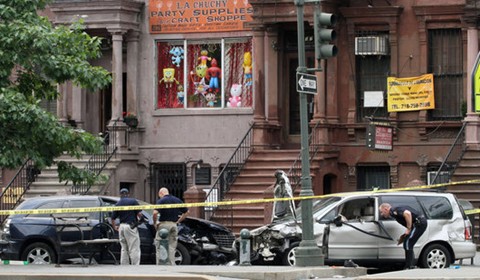
Those of you who follow Microkhan’s microblog know that the situation near headquarters was beyond hectic yesterday—not just because we had the kid on our hands, but also due to our physical proximity to a senseless tragedy. A police pursuit of two robbery suspects ended with a massive collision about 50 feet from our front door, and the death of an elderly nun. As of this writing, the suspects have yet to be caught, though not for lack of beefy detectives peering into our basement for hours on end.
Such fatalities have become alarmingly common in New York, to the point that we think the cops should just let the bad guys go unless lives are at stake. We fail to see how two knucklehead teenage bandits were worth the risk, even if they were armed. When you’re dumb enough to be robbing college kids at 9 a.m., you’re bound to get caught sooner rather than later.
The statistics seem to back up our newfound loathing for police chases in dense urban settings. This 1997 survey contains a data point that supports the widespread notion that 40 percent of police chases end in crashes. And perhaps more alarmingly, the vast majority of chases don’t end with a resolution that can be characterized as a law-enforcement triumph:
In a nationwide study of police chases by the International Association of Chiefs of Police, the most frequent ways a pursuit ended was when a suspect gave up; there was a collision; or the suspect got away.
“What is telling about these statistics is that 72 percent of all pursuits end because of a reason that is almost completely out of the hands of the police,” wrote the study’s authors, Cynthia Lum and George Fachner.
All that said, it must be hard for cops to resist the urge to give chase. We all grew up with dreams of doing this. But New York’s streets and avenues aren’t closed sets, alas.
(Image via The New York Times)


Like gas stations in rural Texas after 10 pm, comments are closed.